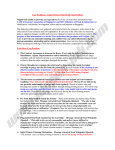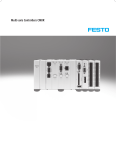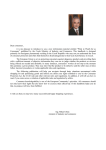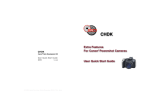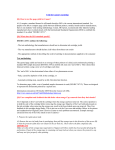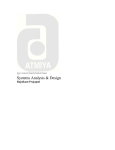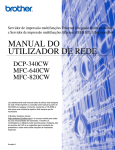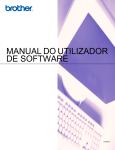Download User Feedback - Void Warranty for using Nippon
Transcript
User Feedback - Void Warranty for using Nippon-ink Cartridges Nippon-ink unable to provide any legal advice but User can seek more information from CASE (Consumer Association of Singapore) and MTI (Ministry of Trade & Industries) for clarification, verification, investigation, action and/or confirmation in Singapore. The following information were gathered and extracted from the respective webs stated in the URL link for User reference and self-explanatory. In case any of the URL link was removed, replace, updated, changes, modify and/or lose at whatsoever reason are beyond our control. The purpose of this information is to let the User understand the products and it rights. This helps to prevent any misunderstanding and conflict from one-sided information due to misrepresentation, misleading and/or misinterpretation. User can have better information before deciding and making it final decision at it owns discretion, responsibility and full liability. Case Study on Void Warranty issues. 1) From the MTI web, under the Anti-Competition Act 2006 Chapter 50B, Part III, Division 2, Section 34, Clause 1 to 5 stated – “Agreements, etc., preventing, restricting or distorting competition”. Refer to MTI Web URL: http://statutes.agc.gov.sg/aol/search/display/view.w3p;ident=bbde084d-33ec-4426-84095ec8870ff458;page=0;query=DocId%3Ae0acb238-cac3-45ec-953094a53928f33a%20Depth%3A0;rec=0;resUrl=http%3A%2F%2Fstatutes.agc.gov.sg%2Faol% 2Fbrowse%2FtitleResults.w3p%3Bletter%3DC%3Btype%3DactsAll#pr34-he 2) Some Original Warranty Card, Carton Box and/or Machine did state that the warranty does not cover on the “Consumables”. The print head (although the design is built-in inside the printer) and inkjet cartridges been clearly specified as consumables. 3) Printer Manufacturer designs the print head to clean by using ink inside the inkjet cartridge to purge out the dirt from the print head. In such situation if the cleaning is not effective and/or failure to perform. Is this the problem of the inkjet cartridge? Can User blame the inkjet cartridge as “Faulty”? Even when User 100% using Original cartridges it still encounter clog and blockage in print head, Why? 4) The dirt been accumulated from Paper Media used and depend on it environment condition. Once dirt mixed with ink and dried up it hardens. Worst, if User did not do any periodic maintenance to purge and clean regularly. Result in serious clog and blockage that unable ink to flow through during printing process. For minor clog, using new cartridges and let it soak for more than 1 day might help to soften and purge it out. Hopefully it can purge out effectively during the next cleaning process otherwise print head need replacement. The ink can dry by other factors, like Capping and Cleaning Mechanism etc. For more detail information, refer to the Print Head Clog Problem articles. 5) The Contract Agreement is between the Buyer (User) and the Seller (Manufacturer, Distributors, Agents, Representatives and/or Retailers). While Nippon-ink sell inkjet cartridges and our limited warranty is on cartridges unless proven with supporting proof and evidences that the inkjet cartridges damaged the machine. 6) In USA – Message extracted from Wikipedia (Quoted) - the Magnuson–Moss Warranty Act is a federal law which states that warrantors can not require that only brand name parts and supplies be used with their product, as some printer manufacturers imply. (Unquote). Refer to URL: http://en.wikipedia.org/wiki/Inkjet_printer 7) In USA - A Businessperson's Guide to Federal Warranty Law – Interested User can refer to the URL: http://business.ftc.gov/documents/bus01-businesspersons-guide-federalwarranty-law 8) From the Legal case of IBM vs United State 1936, indicate below (Quoted): The use of our printer cartridges does not void your printer warranty. The manufacturer of the printer you are using cannot void the warranty on your printer because you use a cartridge or refill kit manufactured by someone other than the printer manufacturer. This prohibition includes the use of compatible cartridges and remanufactured cartridges. U.S. law also prohibits the manufacturers of your equipment from requiring the use of OEM ink or toner or charging extra fees if you use products other than OEM products with their equipment. Those requirements and/or fees are in violation of existing anti-trust acts: The Sherman and Clayton Antitrust Acts (see also: Supreme Court decision: IBM vs. The United States 1936) http://www.usdoj.gov/atr/public/div_stats/1638.htm ; http://www.ftc.gov/bcp/conline/pubs/buspubs/warranty.htm ; IBM vs. The United States (The Sherman and Clayton Antitrust Law) ; The Supreme Court (IBM vs. The United States) held that IBM could not threaten customers with termination of their data processing equipment leases just because they did not use supplies manufactured by IBM. Such practice constituted a tying agreement and was found to be in violation of the Sherman and Clayton Antitrust Law. (Unquote) Information extracted from URL: http://www.apexinktoner.com/compatiblesupplies.html 9) In USA – Message extracted from the Recharge Magazine written by Tricia Judge dated 16th November 2011 (Quoted) – “For years, the cartridge aftermarket has tried to compete with the OEM dealer practice of claiming that the use of aftermarket cartridges will void a printer’s warranty. This practice is prohibited by the Magnuson-Moss Act, and yet it remains pervasive in the marketplace. In addition, the OEMs have found other indirect ways to compel the consumer to purchase their cartridges that smack of anti-competitive tying arrangements”. (Unquote) Information extracted from URL: http://rechargermag.com/articles/2011/11/16/itc-end-voided-warranty.aspx?admgarea=legal 10) In USA – Under the Clayton Anti-Trust Act (1914), Section 14 – Sales etc on agreement not to use goods of competitor (S3 of the Clayton Act) – Refer to URL: http://recycle.consumerchoice.info/bills/ClaytonAntiitrustAct.pdf 11) In United Kingdom (UK) – It fall under the Competition Act 1998, C41, Part I Competition, Section 2 – “Agreement etc. preventing, restricting or distorting competition” – Clause 1 to 8. Refer to URL: http://www.legislation.gov.uk/ukpga/1998/41/contents#pt1-ch2-pb2-l1g18 12) From the above Case Study indicated on item 3, 4, 5, 6 & 8 with the case on IBM vs United States specified clearly that any original intend to tie in any term and condition to the warranty of the product did breach the Anti-Trust and/or Anti-Competition Act. 13) User Fear, Uncertanties and Doubts (FUD) with Threats and Claims by Original OEM Cartridges – Message extracted from Wikipedia (Quoted) –“Most printer manufacturers discourage refilling disposable cartridges or using aftermarket copy cartridges, and say that use of incorrect inks may cause poor image quality due to differences in viscosity, which can affect the amount of ink ejected in a drop, and color consistency, and can damage the printhead. Nonetheless, the use of alternative cartridges and inks has been gaining in popularity, threatening the business model of printer manufacturers. Printer companies such as HP, Lexmark, and Epson have used patents and the DMCA to launch lawsuits against third-party vendors. An anti-trust class-action lawsuit was launched in the US against HP and office supply chain Staples Inc., alleging that HP paid Staples $100 million to keep inexpensive third-party ink cartridges off the shelves.” (Unquote) – Information extracted from URL: http://en.wikipedia.org/wiki/Inkjet_printer . Message extracted from Lawyer and Settlement.com dated November 5, 2006, 12:00:00AM. By Heidi Turner (Quoted) – “Some inkjet companies produce ink cartridges that contain a computer chip that monitors ink use and holds expiry information. This "killer chip," as it is known in the re-manufacturing industry, prevents re-manufacturers from making compatible cartridges. Furthermore, the expiry on the cartridge prevents consumers from using third party cartridges. If you have purchased an inkjet printer in the past four years, it may be unnecessarily shutting down before the ink cartridge is empty, forcing you to buy replacement cartridges before you actually need to” (Unquote). Information extracted from URL: http://www.lawyersandsettlements.com/articles/defective-products/ink-jet-chip-00418.html 14) Inkjet Printer may unnecessarily shutting down before the ink cartridge is “Empty” – Message extracted from PCWorld, by Steve Bass dated Jul 22, 2008 1:00 AM, (Quoted) -"I'm out of ink. Feed me." That was what my Brother 640CW multifunction printer demanded recently. I checked and there was still enough fluid in its cartridge for goodness knows how many more pages. I examined all three allegedly empty cartridges--cyan, yellow, and magenta. From the top to bottom, they measured 1 1/8 inches. There was still roughly 1/4 inch of fluid at the bottom of each one. That's about a fifth of the cartridge's capacity, so my loss in ink was roughly $2.25 per cartridge. Brother’s explanation and replied to the above problem stated by the User - "To address your specific question regarding ink volume, the rated yield for each cartridge follows the industry standard of that period which was based on 5% page coverage. So regardless of what small ink volume you may see remaining in an ink cartridge when it needs to be replaced, we guarantee that the ink volume that was provided and 'used' meets this industry standard calculation. Any additional ink volume left in a cartridge at that time was not put into the rated yield calculation that is guaranteed by Brother. "Importantly, there is a technical and performance reason for why the small amount of ink is remaining in a cartridge that is identified as 'empty.' As mentioned in the User Manual, 'even though the machine informs you that an ink cartridge is empty, there will be a small amount of ink remaining in the ink cartridge. It is necessary to keep some ink in the ink cartridge to prevent air from drying out and damaging the print head assembly.' By doing so, the machine is protected and consistent print quality is ensured to satisfy the consumer. In effect, remaining ink should not be viewed as waste, but as Brother's affirmative action to provide ongoing high quality output and performance of the machine." (Unquote) – Information extracted from URL: https://www.pcworld.com/article/148707/printer_ink_how_do_you_define_empty.html Message extracted from PCWorld, by Rosemary Haworth dated Jun 16, 2007 4:00 am – “As much as 60 percent of the ink contained in a typical inkjet cartridge is wasted, when printers ask users to throw away half-full cartridges, according to research commissioned by Epson. The printer company commissioned research laboratory TUV Rheinland to measure how much ink is used up and how much remains in an inkjet cartridge when the printer claims it's out of ink. The study revealed vast amounts of wastage: no matter which printer you choose, around half the ink you pay for goes unused. On average, inkjet printers provide an ink efficiency of just 58 percent when used for photo printing purposes and 47 percent when used for printing business documents such as presentations. Research company TUV Rheinland performed comparative tests on eight different printers from well-known brands such as HP, Canon, Brother, Lexmark, Epson and Kodak. The Kodak EasyShare model that was included in the test proved to have an ink efficiency level of just 40 percent. By contrast, models made by Epson and one HP inkjet, were shown to have efficiency levels of around 80 percent. The printers that scored particularly poorly were multi-ink cartridge models. This category included printers in which colors are supplied in a single unit of cyan, magenta and yellow as well as six-color printers that have a five-color ink cartridge. The printers each printed as many sample pages as possible until one of the colors was exhausted. The residual amount of ink that was unused was then recorded. TUV Rheinland's Hartmut Mueller-Gerbes explained that tests were carried out separately for photo printing and for business printing. The sample photo prints used were chosen at random by a focus group while a typical PowerPoint presentation was used as the sample document for the business-focused efficiency test. Here, explained Mueller-Gerbes, one color tends to dominate as a presentation will have a particular color theme "such as the light magenta used in our example or the light cyan used in my presentation." Because of this, business printing tends to drain one color faster than any other and the printer alerts the user that replenishment ink is needed. Epson commissioned the tests to measure the environmental impact of ink waste and to back up its assertion that it's less wasteful -- as well as cheaper -- to use a printer that has individual color tanks. Epson sells inkjet printers only that have separate ink cartridges for each color. This means that when one color runs out, the consumer can replace a single cartridge, rather than having to replace all the colors when only one has been used up, as is the case with multiink cartridges. The weight of the inkjet cartridges was taken before and after the tests to ascertain how much ink was in it. They also compared with the weight of an empty cartridge to arrive at a figure for the ink on its own. The cartridges were chemically cleaned to ensure the weight of the cartridge alone was factored in. However, as conference attendees were quick to point out, the tests Epson commissioned did not measure the cost to the consumer, the number of pages each printer was able to produce before running out of color and did not factor in the amount of ink used up by the cleaning cycle that printers routinely perform. This last factor is something industry experts believe accounts for a significant amount of ink waste”. Information extracted from URL: https://www.pcworld.com/article/132969/study_over_half_of_inkjet_printer_ink_is_thrown_away.html Message extracted from Wikipedia (Quoted) - Particularly for printers not used frequently, there are additional costs due to ink wastage in cleaning required with intermittent use, and possible replacement of cartridges which are clogged due to lack of use although not empty. The frequent cleaning conducted by some printers can consume quite a bit of ink and has a great impact on cost-per-page determinations”. (Unquote). Information extracted from URL: http://en.wikipedia.org/wiki/Inkjet_printer#cite_note-21 15) Users’ Feedback and Comments (Others in General) – Message extracted from Data Doctor, Posted by Ken of Data Doctors dated July 24, 2003 (Quoted) – “Obviously, if you damage the printer while attempting to refill the cartridges, it is not covered under warranty, but if you are able to successfully fill and replace the cartridges, the warranty should not be affected. What this really means is that if you want to play it safe, don’t ever take your printer in for service with modified ink jet cartridges installed. I have used inkjet refill kits and other than the hassle and the mess, they seem to work just fine. Ink jet print heads do wear out over time, so you can only refill a cartridge so many times before they become unusable (your mileage may vary). If you plan on using a refill kit, don’t wait until the ink runs out before you refill as some cartridges have a hard time ‘priming’ once they run dry”. (Unquote) Information extracted from URL: http://www.datadoctors.com/help/columns/8688-Do-inkjet-refill-kits-void-my-printer-warranty Message extracted from Wikipedia (Quoted) – “Generally speaking, Canon, Dell, HP, and Lexmark cartridges are not difficult to refill, though some Lexmark cartridges employ a builtin counter chip that can't be reset; Epson cartridges also have a built-in counter chip, however it is possible to purchase a chip resetter. As Brother cartridges generally lack any chip and consist of merely a sack of ink, they can be readily refilled”. Some third party manufacturers have been offering refillable cartridges with an auto reset chip to simplify the refilling process. These refillable cartridges are less harmful to the environment and often easy to further refill. The legality of this industry was brought to the United States Court of Appeals for the Sixth Circuit in the case of Lexmark Int'l v. Static Control Components. The Court ruled that reverse-engineering the handshaking procedure to enable compatibility did not violate the Digital Millennium Copyright Act. HP has fiercely defended its printing interests from the refill industry, including filing patent complaints and false advertising lawsuits which allege that inferior ink is not properly differentiated from the original HP ink. (Unquote) Information extracted from URL: http://en.wikipedia.org/wiki/Ink_cartridge Why Pay More, You can Save! Support – Purchase – Use – Nippon-ink Cartridges! Disclaimer Clause: All Brand Name, Logo, Trademark, Part Number, Picture, Design, Patent, Copyright and Technology belong to the respective owners in charge. All other Rights reserved.






